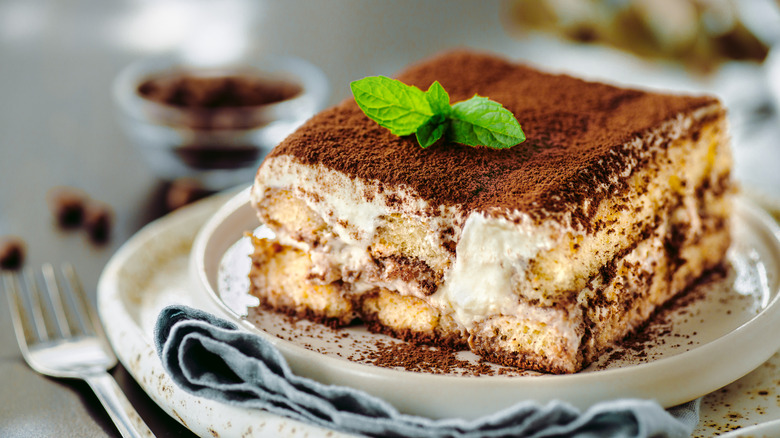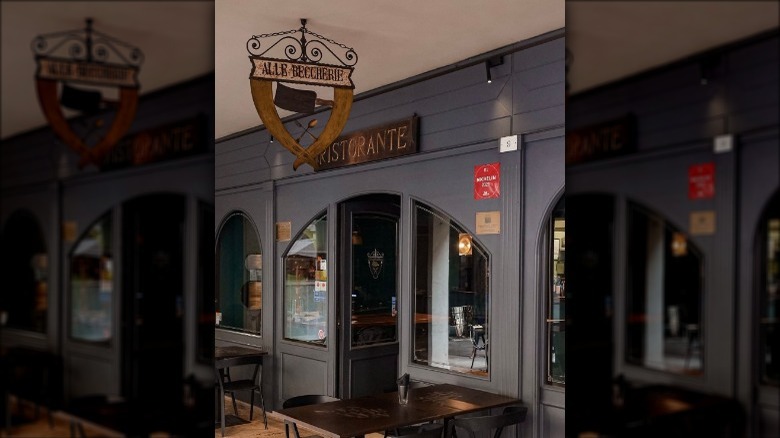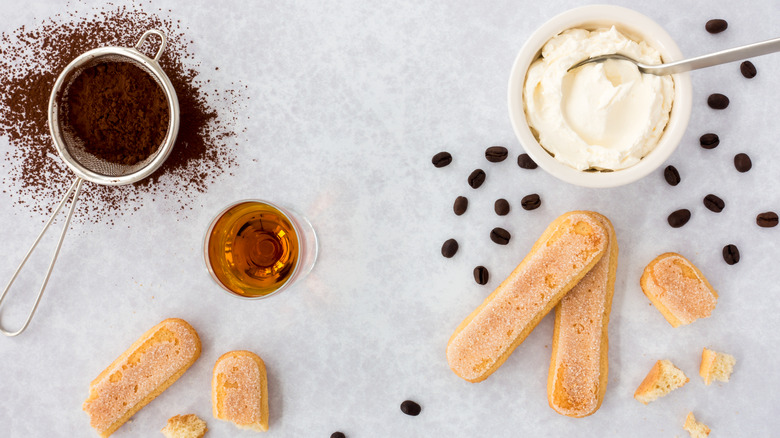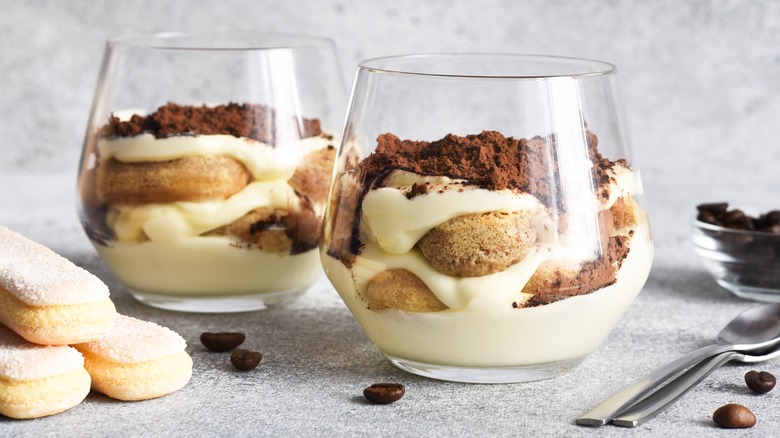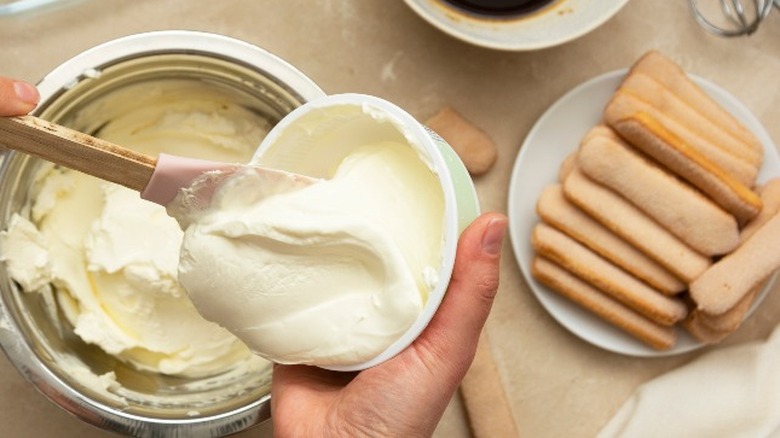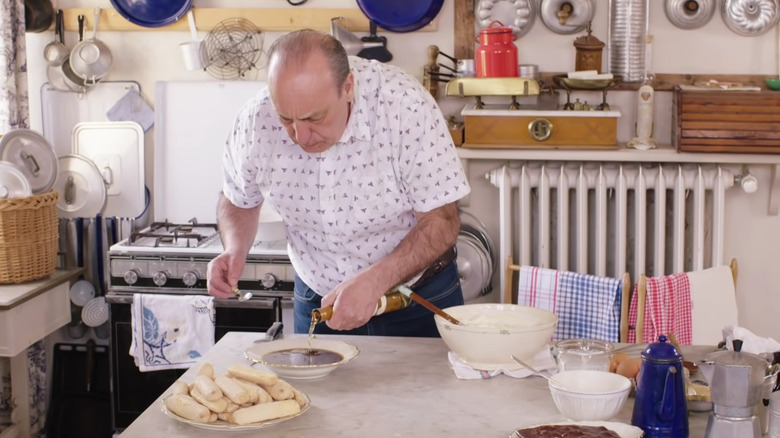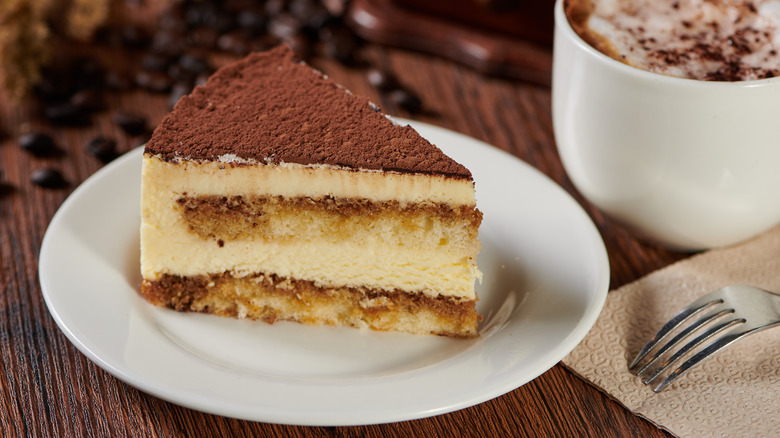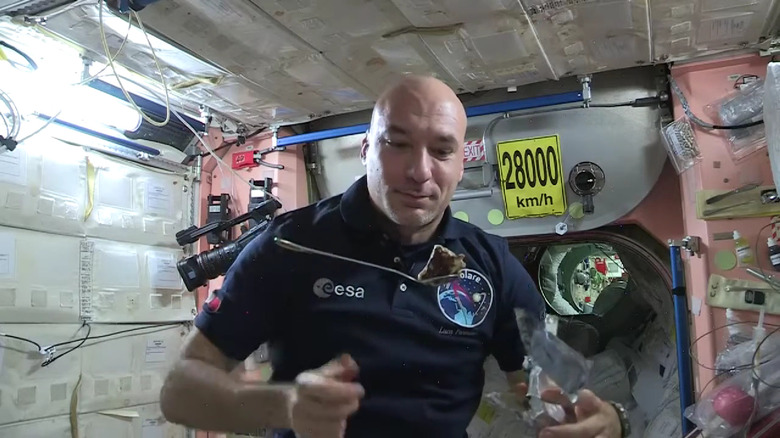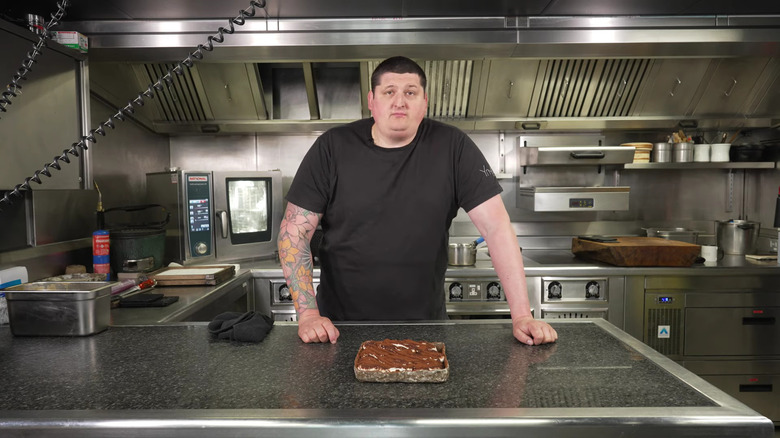A Beginner's Guide To Tiramisu
Cannoli and gelato have been around for centuries and have become an integral part of Italian cuisine. On the other hand, tiramisu is something of a newcomer to the global dessert scene. This indulgent dessert rose to prominence during the latter part of the 20th century. Tiramisu originated in the Northern Italian provinces of Veneto and Friuli Venezia Giulia, as reported by National Geographic. The dessert arrived on American soil in the 1980s and rapidly became one of the nation's most prestigious, luxurious desserts, according to The New Yorker.
The dessert's flavor profile became so popular that brands began using it in their products. Today, you can find tiramisu-flavored protein powder, liqueur, coffee, and more.
While there are plenty of variations of the classic tiramisu recipe (via Lasso the Moon), the dessert is still most beloved in its original form. So adored is tiramisu that Great Italian Chefs has even gone so far as to suggest that this humble newcomer has already become the most famous dessert in Italy.
It is thought to have been invented at Le Beccherie
Even though tiramisu was created in living memory, its origins remain contested. The most accepted story is that the dessert was created at Le Beccherie, a restaurant in Treviso, Italy. At the time of tiramisu's creation, Le Beccherie was under the ownership of Ado Campeol, whose family founded the restaurant in 1939 (per BBC).
The exact story of how tiramisu was invented in the kitchens of Le Beccherie differs depending on who is telling the story. Some suggest that Alba Campeol, Ado's wife, invented it as a pick-me-up during and after her pregnancy, according to a piece published by the Daily Mail. However, others suggest it was the fortuitous result of mascarpone cheese being dropped into a bowl of sugar and eggs, as reported by BBC.
The recipe perfected by the Campeols is still being made at Le Beccherie today. Paolo Lai, the current owner who bought the restaurant from the Campeols in 2014, has kept the original recipe on the menu, as noted by The New Yorker, although a more contemporary alternative is also available (via Le Beccherie).
The dish was championed by Italian epicure Giuseppe Maffioli
Every good gastronomic invention needs a champion — a prominent figure that can sing its virtues until enough people come to appreciate it. The bloody Mary had Ernest Hemingway (per Esquire), Campbell's soup had Andy Warhol (via CNN), and tiramisu had Giuseppe Maffioli. Maffioli might not have a name that's as well-known as those of Hemingway and Warhol, but his impact on the dessert was equal — if not greater — than those of his contemporaries. As reported by inews.co.uk, it was actor and epicure Maffioli who caused tiramisu to rise from Le Beccherie's house dessert to a national icon.
Maffoli achieved this by writing an article in 1981 for Vin Veneto, an Italian magazine, as noted by Chef Academy of London. However, in Maffioli's version of events, the dessert was created by Loli Linguanotto alone. Linguanotto has never confirmed nor denied that the dessert was his idea, and he continues to be associated with tiramisu as a judge and guest at the annual Tiramisu World Cup.
Only six ingredients are used to make a classic tiramisu
As with other popular dishes in Italian cuisine, tiramisu is favored for its simple, bold, and balanced flavor profile. This comes as a byproduct of the dessert's extremely concise ingredients list that includes sugar, eggs, espresso, mascarpone, cocoa powder, and savoiardi. The widespread appeal of Italian dishes made with this approach was explained by Elia Sebregondi, the head chef at Officina 00, a popular restaurant in London. In an interview with Speciality Food, she stated, "Italian food is so popular because so many of the ingredients and dishes are simple, but do not compromise flavor, making it accessible to a wide range of people."
Both flavor and accessibility are key to tiramisu's popularity, as they mean the dish can be equally enjoyed in the finest of dining settings or at home. Yet, even with such a basic ingredients list for tiramisu, you can still end up with widely varying desserts. One such cause of this divergence is the way in which the eggs are used. Restaurants from the two regions that stake a claim to tiramisu — Veneto and Friuli Venezia Giulia — have long disagreed on this point. The former uses just the yolks, while the latter incorporates the egg whites as well, which results in an airier tiramisu, as explained by food writer Felicity Cloake in an article for National Geographic.
The contested origin of tiramisu has caused tensions
Tiramisu has long been a dessert worth fighting for. At least, that's how many Italians feel. Attempts to protect the dish from adulteration include a bid by Luca Zaia — the president of Veneto — to win Traditional Speciality Guaranteed certification from the European Commission, a scheme that has seen other famous Italian dishes, such as pizza napoletana, become protected (via The Guardian).
Unfortunately for Zaia and his Veneto compatriots, the only status tiramisu has been assigned is that of a product from the neighboring region of Friuli Venezia Giulia. As explained by Italian magazine editor Silvia Donati (via Italy Magazine), this result is a crushing blow for Veneto's claim to the dessert. Perhaps somewhat unsurprisingly, Zaia made a cutting statement after hearing the news. "The ministry has effectively said that it counts for nothing that five million Veneto people recognize tiramisu as one of their typical dishes and that it counts for nothing that we have an industry based around this product," he stated (via The Telegraph). Unfortunately for Zaia, his complaints have landed on deaf ears, and tiramisu continues to be recognized as a dish from Friuli Venezia Giulia to this day.
It became widely popular in the 1980s
Tiramisu's arrival on the U.S. dining scene was announced in a New York Times article written by Marian Burros, a long-established food writer and columnist. In the article from 1985, Burros notes the differences in tiramisus around New York City and suggests that the increased availability of Italian products may have contributed to the dessert's rise in popularity stateside. Burros' latter observation has been supported by an analysis published in Global Food History.
The increase of exported goods from Italian companies to the U.S. helps explain how tiramisu became popular in America. However, it doesn't explain why the dessert became so popular. Diego Zancani, a professor at The University of Oxford and author of multiple food-related books, suggested to National Geographic that a sense of luxury had something to do with it. "Tiramisu became so iconic because it represented an enhanced, luscious version of an Italian classic, the humble gelato — maybe crossed with a Black Forest gateau," he explained. "It was a really satisfying, versatile pick-me-up."
Two classic Italian products form the basis of tiramisu
Of the six ingredients required to make tiramisu, there are two that stand out as historic Italian products in their own right: mascarpone and savoiardi. As explained in Culture, mascarpone is a unique cheese that is featured in many Italian dishes and is a key part of all tiramisus. Mascarpone features no starter culture, which means it must be sold, bought, and consumed when fresh. Because mascarpone cannot be shipped from Italy, many tiramisu makers utilize alternative ingredients, such as creme fraiche (per MasterClass). Fortunately, the growing global popularity of Italian cuisine means many non-Italian dairy farmers have started producing the creamy cheese, such as Crave Brothers Farmstead Cheese in Wisconsin.
The second notable ingredient in tiramisu is savoiardi, which is a traditional, low-density, and crumbly biscuit thought to have been invented at the Duchy of Savoy (per Taste Atlas). Savoiardi quickly became a feature in Italian desserts due to their ability to absorb liquids, a fact highlighted in La Cucina Italiana. The use of savoiardi is absolutely essential in making tiramisu. Not only do the biscuits absorb the espresso or alcohol, but they also form the structural base of the dessert and allow it to be constructed in its classic, freestanding form.
There is an annual Tiramisu World Cup
Despite having had the indignity of seeing tiramisu assigned as a product of the neighboring region Friuli Venezia Giulia, Veneto still has the privilege of hosting the dessert's most famous competition, the annual Tiramisu World Cup. The Local reports that the finals are held in Treviso each year, and the competition is split into two categories, traditional and creative, per the competition's website.
The traditional category strictly enforces the sole use of the six traditional ingredients; all variables, including brand type and coffee strength, are controlled. The creative category is much more relaxed and allows competitors to put their own spin on the recipe. The 2021 winning entry in the Tiramisu World Cup's creative category was by Elena Bonali and featured the use of both Parma ham and melon.
While the competition only welcomes 200 competitors each year, winning it can result in a myriad of opportunities. The two winners in 2019, Fabio Peyla and Sara Arrigoni, were flown to Curitiba, Brazil, as guests of the Italian Embassy to attend the Week of Italian Cuisine in the World, an initiative designed to promote the global appeal of the cuisine (per Tiramisu World Cup).
Alcohol is a common addition
Although it isn't one of the traditional ingredients in tiramisu, alcohol is often incorporated into the recipe to provide a boozy and sugary kick. Unlike many alcohol-laced dishes, tiramisu is not heated, which means the alcohol does not get cooked off. As such, care should be taken when adding alcohol to ensure the dessert does not become overly alcoholic or have its flavor profile dominated by the booze.
The common consensus, and one backed by esteemed Italian food writer Anna Del Conte, is that brandy is the best spirit to use when making tiramisu, thanks to its sweet and fruity flavor profile (via The Guardian). However, other popular spirits to include in the recipe include dark rum and amaretto.
For those unwilling to sully the classic tiramisu recipe with new ingredients, alcohol can be included as a pairing instead. Fiona Beckett, a wine writer whose work is featured in Decanter and The Guardian, recommends pairing the dessert with oxidized, sweet wines, such as Corsican Rappu. The complex, fruit and nut-like flavor profile makes the wine a perfect companion to the Italian dessert (via Matching Food and Wine).
Good coffee is the secret to a great tiramisu
While alcohol is an optional ingredient in tiramisu, coffee is absolutely essential. Strong coffee is usually used to balance out the sweetness of tiramisu. It also provides the much-lauded caffeine boost for which the dessert is known.
Typically, espresso is the form of coffee that is used to make tiramisu. Aside from being the traditional choice, freshly-brewed espresso is also the best choice, a fact attested to by Elisa Urdich, an award-winning Italian coffee brewer. In research performed for Perfect Daily Grind, Urdich and several chefs from Le Beccherie concluded that espresso is the only type of coffee that produces the bitter flavor required to counteract the inherent creaminess of the dessert. They also advised against using acidic coffees, which react poorly with the high dairy content of tiramisu.
Many households don't have access to an espresso machine due to the cost and space required. According to Perfect Daily Grind, a stovetop moka pot is a great alternative for brewing espresso. This kitchen tool is a cost-effective means of producing flavorful and strong coffee that, while not technically espresso, is perfect for incorporation into tiramisu (via Blue Bottle Coffee).
It benefits greatly from time in the fridge
Tiramisu is adored by professional chefs around the world because it can be made in advance, kept in the fridge, and served immediately when ordered. However, making tiramisu ahead of time doesn't just make things easier when it comes to serving — it also maximizes the quality of the dessert.
Those at DeLallo, a family-owned importer, producer, and distributor of Italian culinary products, suggest refrigerating tiramisu for six hours before eating it. In an interview with C-Ville Weekly, Joy Kuhar, former pastry chef at the now closed Cafe Bocce in Charlottesville, Virginia, swore that refrigerating the dessert for 24 hours is the best way to go. She stated that tiramisu only gets better with time. This can be explained by research provided by the Institute of Food Technologists. In the publication, Guy Crosby, science editor for America's Test Kitchen and adjunct professor at Harvard University, highlights how food left in the fridge overnight — or longer — continues to undergo chemical changes. These changes result in the formation of molecules that add or enhance flavors over time. Prolonged periods in the fridge will also ensure that the tiramisu has time to firm up, allowing portions to be cut cleanly and accurately.
Tiramisu has been enjoyed in some unlikely places
Tiramisu has been enjoyed in some extremely prestigious restaurants around the world, including the Michelin-starred Racines (via Vogue). Yet, white-clothed dining tables have not provided the most fascinating setting in which the dessert has been eaten. Rather, this accolade goes to the International Space Station.
Luca Parmitano, an Italian astronaut, was the first person to bring tiramisu into space. He took the dessert with him as part of an Italian-themed dinner in an effort to impress his colleagues. "Being Italian, I have a very special relationship with the culinary arts," Parmitano said in an interview (via Space.com). "One of my projects was to share Italian cultural food with my colleagues. When I made the simple request of creating a menu for myself and my crew, the Italian Space Agency jumped on the request." The menu in question included two risottos, baked aubergines, and Marsala wine-spiked tiramisu.
Here on Earth, tiramisu has also found an unlikely home, this time in fast food restaurants. As reported in MyLondon, the dessert is common on the menus of Italian McDonald's restaurants, while a tiramisu-flavored McFlurry has recently hit stores in the U.K. (via Bristol Live).
Tiramisu can be made and served in a number of ingenious ways
With people like Luca Zaia campaigning so vehemently for the protection of tiramisu, the idea of altering the traditional recipe can prove a nerve-wracking one. Nonetheless, alternatives to the original recipe abound, many of which aim to cater to those who cannot eat the original, dairy-rich recipe. One such example comes from award-winning chef and climate change activist Tom Hunt. Hunt produced a plant-based tiramisu recipe for The Guardian. The vegan tiramisu recipe calls for silken tofu, used coffee grounds, soy yogurt, and aquafaba, which is chickpea water.
Of course, fine dining restaurants are another key source of tiramisu innovation. Perhaps the best example of this comes from Ynyshir in Wales, a restaurant with two Michelin stars. In a review published by The Guardian, leading food critic Grace Dent lauded chef Gareth Ward's deconstructed tiramisu. His take on tiramisu includes frozen mascarpone alongside the sweet punch of marsala wine.
